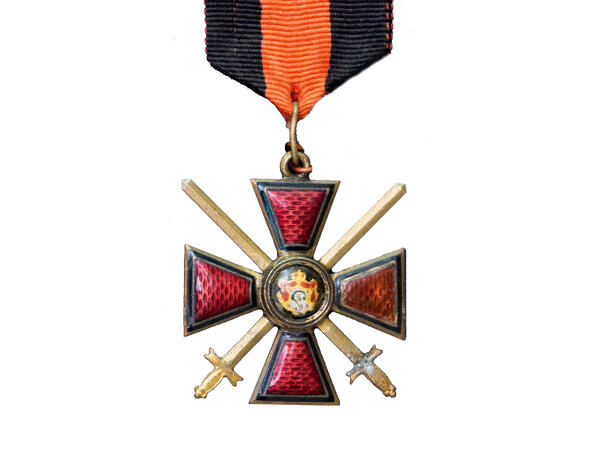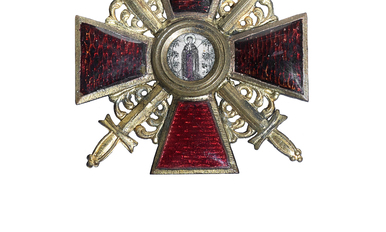The Order of St. Vladimir, 4th class, was made in the form of a four-pointed cross. The award was cast in yellow metal and covered with red enamel for durability.
The edges of the cross were decorated with gold and black borders. On the front side, in the center of the order, a rosette with an ermine mantle was placed, on which the monogram of St. Vladimir was depicted under the grand-ducal crown. Two crossed swords passed through the middle of the order. On the reverse side, the date when the award was established was inscribed: “September 22, 1782”
The Order of St. Vladimir had a motto: “Benefit, honor and glory.” The award was worn on a moire red ribbon with a black border along the edges.
The order was established by Catherine II on the 20th anniversary of her reign. It existed in four classes and was awarded both for civilian distinctions and for military merits.
The award was given in accordance with the Table of Ranks — a special list of ranks and estates. Those who held civil or military ranks at least of the third class could become recipients of the first class: Privy Councillors, lieutenant generals and vice-admirals. The Order of the 2nd degree was awarded to those who had at least the fourth class: actual state councilors, major generals, and rear admirals. The 3rd class of the order was awarded to those who were in ranks and estates not lower than the fifth class —for example, state councilors, brigadiers, and captains-commanders. And the award of the 4th class was given to court advisers, lieutenant colonels and captains of the second rank not lower than the seventh class.
On August 17, 1855, crossed swords were added to the order, which was awarded for military exploits. In 1857, to distinguish between officers and civil servants, awards were made with different details. For distinction in battles, officers received an additional badge with a sword and bow, and officials for civil services received only a badge with swords.
When the officer received a higher class, the crossed swords were transferred from the old award to the new one. However, in this case, they were placed not in the center of the cross, but slightly higher. Such awards “with swords over the order” were issued until the end of 1870.
The Order of St. Vladimir of the 4th class with swords, presented in the museum exposition, is a sample of the award that was awarded to Pavel Vasilyevich Presnukhin, the second lieutenant, participant in the defense of Sevastopol, on October 26, 1855, for “exemplary bravery in the defense of Sevastopol”. He was in the garrison of Sevastopol from October 11, 1854.
Initially, together with the battalion on the Shipborne side of the city, he built new and repaired the destroyed fortifications, and in 1855 he was in front of the 4th bastion and supervised the underground mining operations. At different times during the defense, Presnukhin was severely shell-shocked four times.
The edges of the cross were decorated with gold and black borders. On the front side, in the center of the order, a rosette with an ermine mantle was placed, on which the monogram of St. Vladimir was depicted under the grand-ducal crown. Two crossed swords passed through the middle of the order. On the reverse side, the date when the award was established was inscribed: “September 22, 1782”
The Order of St. Vladimir had a motto: “Benefit, honor and glory.” The award was worn on a moire red ribbon with a black border along the edges.
The order was established by Catherine II on the 20th anniversary of her reign. It existed in four classes and was awarded both for civilian distinctions and for military merits.
The award was given in accordance with the Table of Ranks — a special list of ranks and estates. Those who held civil or military ranks at least of the third class could become recipients of the first class: Privy Councillors, lieutenant generals and vice-admirals. The Order of the 2nd degree was awarded to those who had at least the fourth class: actual state councilors, major generals, and rear admirals. The 3rd class of the order was awarded to those who were in ranks and estates not lower than the fifth class —for example, state councilors, brigadiers, and captains-commanders. And the award of the 4th class was given to court advisers, lieutenant colonels and captains of the second rank not lower than the seventh class.
On August 17, 1855, crossed swords were added to the order, which was awarded for military exploits. In 1857, to distinguish between officers and civil servants, awards were made with different details. For distinction in battles, officers received an additional badge with a sword and bow, and officials for civil services received only a badge with swords.
When the officer received a higher class, the crossed swords were transferred from the old award to the new one. However, in this case, they were placed not in the center of the cross, but slightly higher. Such awards “with swords over the order” were issued until the end of 1870.
The Order of St. Vladimir of the 4th class with swords, presented in the museum exposition, is a sample of the award that was awarded to Pavel Vasilyevich Presnukhin, the second lieutenant, participant in the defense of Sevastopol, on October 26, 1855, for “exemplary bravery in the defense of Sevastopol”. He was in the garrison of Sevastopol from October 11, 1854.
Initially, together with the battalion on the Shipborne side of the city, he built new and repaired the destroyed fortifications, and in 1855 he was in front of the 4th bastion and supervised the underground mining operations. At different times during the defense, Presnukhin was severely shell-shocked four times.



